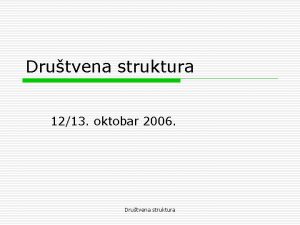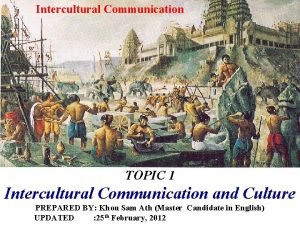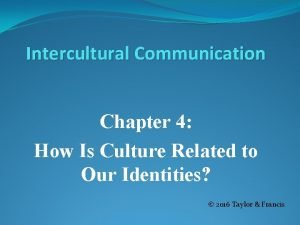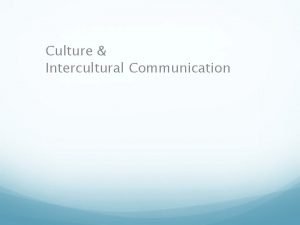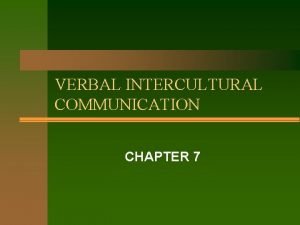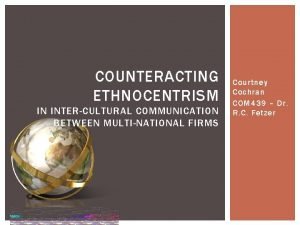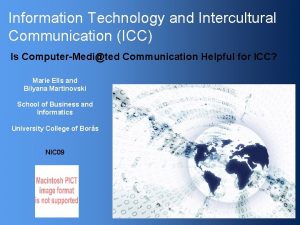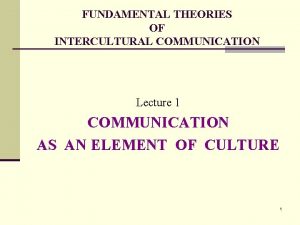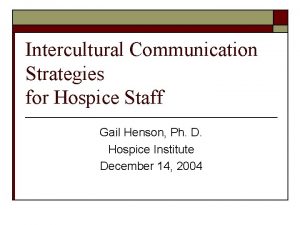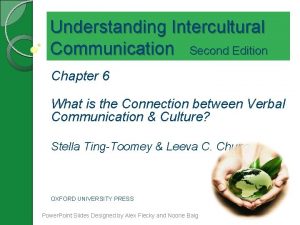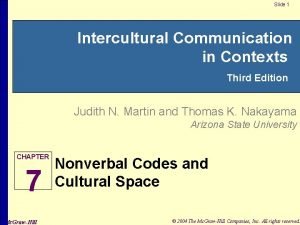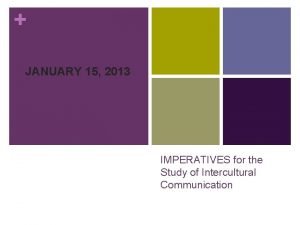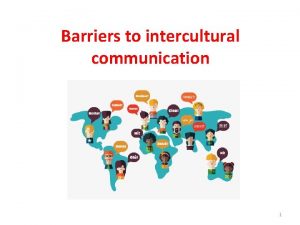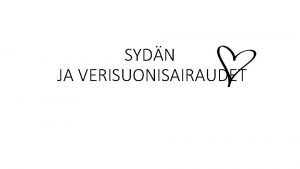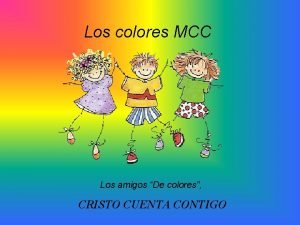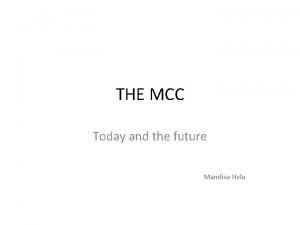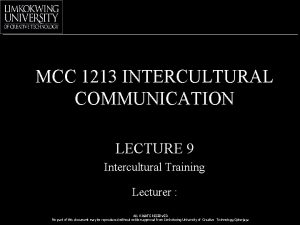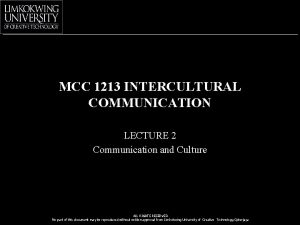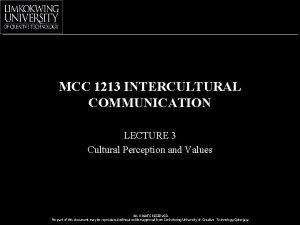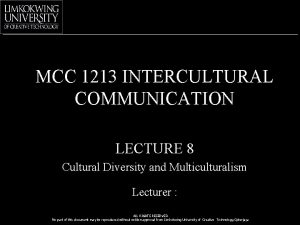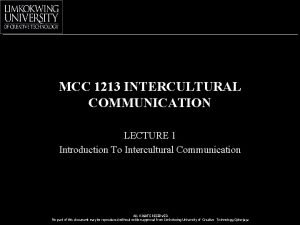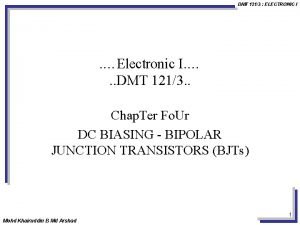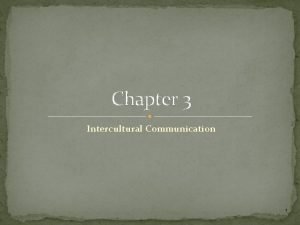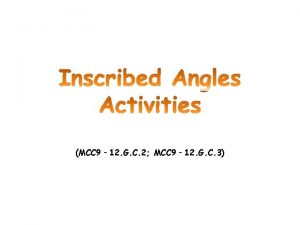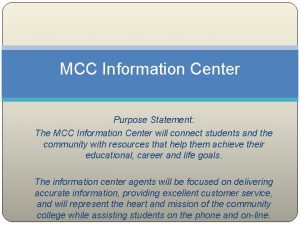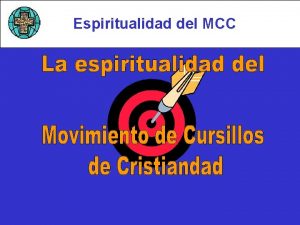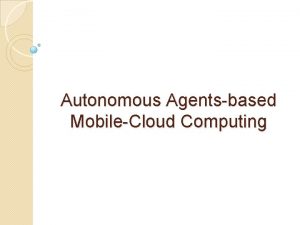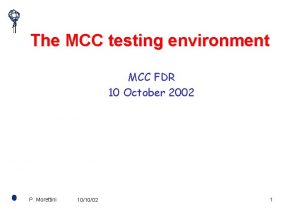MCC 1213 INTERCULTURAL COMMUNICATION LECTURE 5 Intercultural Relationship
























- Slides: 24

MCC 1213 INTERCULTURAL COMMUNICATION LECTURE 5 Intercultural Relationship Development ALL RIGHTS RESERVED No part of this document may be reproduced without written approval from Limkokwing University of Creative Technology, Cyberjaya

Learning Outcome • Understand the meaning, characteristic, stages, and theories of relationship development • Understand the impact of culture on relationship development • Understand the model of third-culture building ALL RIGHTS RESERVED No part of this document may be reproduced without written approval from Limkokwing University of Creative Technology, Cyberjaya

The Nature Of Human Relationship • Refer to how we deal with one another in daily life • “social needs” (Schutz, 1966) • 3 social needs in communication - (a) inclusion is sense of belonging (b) control is the ability to be in charge of our own life and to influence people around us (c) affection is the desire to show our love to be loved by others ALL RIGHTS RESERVED No part of this document may be reproduced without written approval from Limkokwing University of Creative Technology, Cyberjaya

Characteristics of Human Relationship • • • Human relationships are dynamic Human relationship are hierarchical Human relationships are reciprocal Human relationships are unique Human relationships are interdependent and irreplaceable ALL RIGHTS RESERVED No part of this document may be reproduced without written approval from Limkokwing University of Creative Technology, Cyberjaya

Stages Of Relationship Development entry phase personal phase exit phase ALL RIGHTS RESERVED No part of this document may be reproduced without written approval from Limkokwing University of Creative Technology, Cyberjaya

Devito's Model (1992) • Six stage model of human relationship development: • Contract - our attention on our partner's physical appearance • Involvement - connect one to the other by developing an association ALL RIGHTS RESERVED No part of this document may be reproduced without written approval from Limkokwing University of Creative Technology, Cyberjaya

• Intimacy - show commitment to each other and become best friends or lovers • Deterioration - dissatisfactory interaction • Repair • Dissolution - cut off the connection ALL RIGHTS RESERVED No part of this document may be reproduced without written approval from Limkokwing University of Creative Technology, Cyberjaya

Knapp and Vangelisti Model (1992) • Divided the process of relationship development into 2 parts • A. Coming together - five stages: 1. Initiating 2. Experimenting 3. Intensifying 4. Integrating 5. Bonding ALL RIGHTS RESERVED No part of this document may be reproduced without written approval from Limkokwing University of Creative Technology, Cyberjaya

B. Coming apart - five stages 1. Differentiating 2. Circumscribing 3. Stagnating 4. Avoiding 5. Terminating ALL RIGHTS RESERVED No part of this document may be reproduced without written approval from Limkokwing University of Creative Technology, Cyberjaya

Chen's Model (1995) • The development of human interaction process build on 3 ontological assumptions: 1) Human relationship is ever in a state of change and transformation 2) Human relationship changes according to cycle e. g. night and day 3) The development of human relationship is never absolutely complete or finished • Based on 8 trigrams representing eight attributes of human nature. ALL RIGHTS RESERVED No part of this document may be reproduced without written approval from Limkokwing University of Creative Technology, Cyberjaya

Social Exchange Theory (Kelly & Thibaut, 1978) • Based on 2 economic concepts : rewards and cost • Constantly measure the difference between rewards and costs • When reward is greater than cost, we acquire • When cost is greater than reward, we reject ALL RIGHTS RESERVED No part of this document may be reproduced without written approval from Limkokwing University of Creative Technology, Cyberjaya

Social Penetration Theory (Altman & Taylor, 1973) • Determined by the information we disclose to our partner dimension of width and depth • 4 stages of relationship development: • - orientation, • - exploratory • - affective exchange and • - stable exchange ALL RIGHTS RESERVED No part of this document may be reproduced without written approval from Limkokwing University of Creative Technology, Cyberjaya

Uncertainty Reduction Theory (Berger 1979) • Examines the ways we come to know each other in the initial stage of development • Uncertainty refers to our cognitive inability to explain our own or other's feelings and behaviors in interactions because of an ambiguous situation that evolves anxiety • To reduce uncertainty level: passive, active and interactive strategies. ALL RIGHTS RESERVED No part of this document may be reproduced without written approval from Limkokwing University of Creative Technology, Cyberjaya

THE NATURE OF NONVERBAL COMMUNICATION • Involves those humanly and environmentally generated stimuli in a communication setting that convey potential nonlinguistic message values to the interactants (Samovar & Porter, 1995) • Successful interaction in intercultural settings requires not only the understanding of verbal messages but of nonverbal messages as well. ALL RIGHTS RESERVED No part of this document may be reproduced without written approval from Limkokwing University of Creative Technology, Cyberjaya

Functions Of Nonverbal Communication • Repetition - to repeat what we say orally e. g. showing direction • Replacement - to substitute for verbal messages • Emphasis - emphasize or accept the feelings or emotions conveyed by verbal messages by adding more information to the expressions ALL RIGHTS RESERVED No part of this document may be reproduced without written approval from Limkokwing University of Creative Technology, Cyberjaya

• Contradiction - contradict the meanings of verbal messages • Regulation - to tell someone to do or not to do something. ALL RIGHTS RESERVED No part of this document may be reproduced without written approval from Limkokwing University of Creative Technology, Cyberjaya

The Structure Of Nonverbal Communication A. Kinesics - The study of body movements and activities in human communication - Body language - classified into five categories: emblems, illustrators, regulators, affect displays, and adaptors (Ekman & Friesen, 1972) ALL RIGHTS RESERVED No part of this document may be reproduced without written approval from Limkokwing University of Creative Technology, Cyberjaya

Emblems • Used to replace verbal messages Illustrators • Directly tied to speech and that are used to describe, reinforce, or supplement what is said verbally Regulators • To influence or control others behaviors Affect displays • Bodily and facial expressions that convey our feelings and emotion cross-currently ALL RIGHTS RESERVED No part of this document may be reproduced without written approval from Limkokwing University of Creative Technology, Cyberjaya

Adaptor • Body movements that usually occur when we are in anxious situations (often unconscious) Facial Expressions • A person's character is clearly written on his or her face • Across cultures, the same facial expression may acquire different meanings e. g. Japanese smiles not only expresses happiness and affection but also to avoid embarrassment and unpleasantness ALL RIGHTS RESERVED No part of this document may be reproduced without written approval from Limkokwing University of Creative Technology, Cyberjaya

Eye Contact • Shakespare “your lips tell me no, but there is yes, yes in your eyes. • Oculesics - the study of eye contact in communication process. Hand Gestures • Hand gestures as symbols in communication • We use a wide range of hand gestures to “talk” with each other in daily communication • Hand gestures are culturally determined. ALL RIGHTS RESERVED No part of this document may be reproduced without written approval from Limkokwing University of Creative Technology, Cyberjaya

Touch • The study we use touch in communication is called haptics • Touch is used not only to convey caring and nurturance, but also signify (1) professional relationship (touched by a medical doctor) (2) social relationship (hugging) (3) friendship (holding hands), (4) intimacy (kissing), (5) sexual arousal (embracing) - Heslin & Alper (1983) ALL RIGHTS RESERVED No part of this document may be reproduced without written approval from Limkokwing University of Creative Technology, Cyberjaya

B. Proxemics - How we use space in communication process - Three kinds of space: (1) fixed-feature space - unmovable structural arrangements around us, (2) semi fixed feature space - arrangement of movable objects that we don't move unless a special need arises, (3) informal space - the distance between the interactants in communication ALL RIGHTS RESERVED No part of this document may be reproduced without written approval from Limkokwing University of Creative Technology, Cyberjaya

C. Paralanguage - The use of vocal signs in communication - Vocal cues to detect the emotional status of the speaker in communication ALL RIGHTS RESERVED No part of this document may be reproduced without written approval from Limkokwing University of Creative Technology, Cyberjaya

D. Chronemics - The study of how we use time in communication (Hall, 1959) • Formal time • Technical time • Informal time - Present, Past and Future Time Orientation - Monochronic and Polychronic Time Orientation ALL RIGHTS RESERVED No part of this document may be reproduced without written approval from Limkokwing University of Creative Technology, Cyberjaya
 1213 znacenje
1213 znacenje 01:640:244 lecture notes - lecture 15: plat, idah, farad
01:640:244 lecture notes - lecture 15: plat, idah, farad Discrimination as a barrier to intercultural communication
Discrimination as a barrier to intercultural communication Intercultural communication meaning
Intercultural communication meaning Intercultural communication questions
Intercultural communication questions Avowal intercultural communication
Avowal intercultural communication Intercultural communication youtube
Intercultural communication youtube Intercultural communication notes
Intercultural communication notes Staircase model of intercultural communication
Staircase model of intercultural communication Example of verbal intercultural communication
Example of verbal intercultural communication Nonverbal intercultural communication
Nonverbal intercultural communication Intercultural communication conclusion
Intercultural communication conclusion Ethnocentrism intercultural communication
Ethnocentrism intercultural communication Intercultural communication model
Intercultural communication model Technology and intercultural communication
Technology and intercultural communication Theories of intercultural communication
Theories of intercultural communication Strategies for improving intercultural communication
Strategies for improving intercultural communication Linear vs relational worldview
Linear vs relational worldview Intercultural communication in contexts
Intercultural communication in contexts Demographic imperative intercultural communication
Demographic imperative intercultural communication 4 barriers of intercultural communication
4 barriers of intercultural communication Hypertonia arterialis
Hypertonia arterialis Los colores de los amigos
Los colores de los amigos Mcc today
Mcc today Ota programs in michigan
Ota programs in michigan
